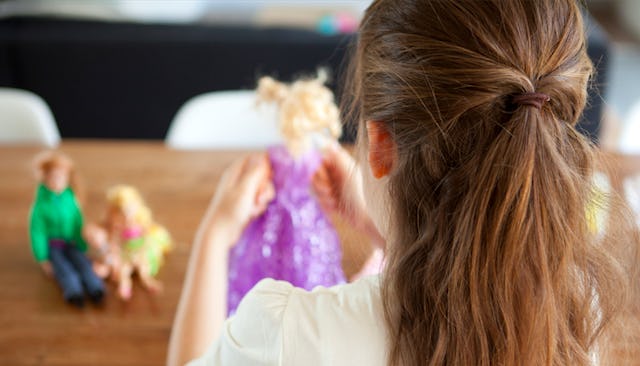As A Father, I'm Glad Barbie Has Finally Evolved

I received a box from Mattel as part of a promotion called “Dad’s Who Play Barbie.” I have two daughters. The oldest is almost 8, and the youngest is about to turn 3. In the past, I haven’t always been a huge fan of Barbie. Not simply because of the way it tries to cast women into an unachievable and arbitrary body type, but also because the books and media they produce tend to draft a female narrative that is vapid and vain. As a father of two young girls, I’ve started to realize there are two things that are incredibly difficult to avoid: Disney Princesses and Barbie.
My 7-year-old, Norah, has several Barbies, so when she saw me bring home a big pink box with Barbie written on it, she almost ripped it out of my hands. I called her younger sister into the room, and they opened it together. There were three dolls inside. One was the kind of Barbie I was used to seeing: blonde, white, and impossibly thin, with large breasts. Outside of having a mermaid tail, she was basically what I expected. The other two, though, were a little different. One was a short, slender, woman of color wearing a physician’s coat. She was listed as a doctor. The other had blue hair, was short, with defined hips, and was labeled as “curvy.”
Turns out this was all part of a new line of Barbies where Mattel is beginning to manufacture dolls from different races, body types, and backgrounds. I will admit, I was happy to see this shift. However, what was the most interesting was how my daughters reacted to them.
Norah, the oldest, grabbed the traditional Barbie, with long blonde hair, and didn’t want anything to do with the other two dolls. And I will admit, this gave me pause. She was 7. I’d like to think that I’ve done a good job of talking to her about how the world is made up of different people, and that we need to be celebrating difference and not discriminating. But while I’m trying to craft my daughter as an accepting, open-minded, young woman, there is this other narrative all around her, showing her that she needs to be tall, blonde, well-endowed, and live in a large home with a pool and a cute little dog where all her friends come over with their little dogs and throw pool parties.
Norah is very short for her age, with brown hair and a sweet smile. Her parents are middle class, and live in a small home in rural Oregon. In fact, Norah looks a lot like her mother. Mel only stands slightly over 5 feet. She’s never going to look like Barbie, and that isn’t a bad thing at all. But when I saw her immediately reach for that standard Barbie doll, I paused, and wondered what she already thought about how women should look and act, and I worried it may already too late to change her perceptions of womanhood.
Her younger sister, Aspen, on the other hand, didn’t hesitate for one moment. She grabbed the remaining two dolls, tore open their packaging without a care for what a Barbie had looked like in the past, and started playing. And in that moment, I felt hopeful for one daughter, but nervous about the other.
I know that there are going to be some people reading this that will assume I’m overreacting. Maybe I am. Parenting has the tendency to bring that out in us at times. But I know that I want the best for my daughters, and the last thing I want them to be is saddled with some arbitrary script of success and beauty that isn’t really true, and isn’t all that achievable, and hold themselves to these impossible standards.
I want Norah and Aspen to grow up and become who they want to be, whether it is an astronaut, medical doctor, or stay-at-home mom. I also want them to look out at the world and celebrate the fact that everyone is different, and one race, gender, or religion is not superior to another, and that differences should be celebrated. I really want them to feel comfortable in their own skin, so when I see a moment like I did with these dolls, it feels like the seeds of emotional failure and discrimination were already planted, regardless of my efforts. That society’s ideals had somehow taken root, even though my daughter was still so young.
But then something remarkable happened. Norah played with her Barbie on the sofa, while Aspen played with her two dolls next to the TV. About 20 minutes in, they started to play together, which is unusual, and eventually, both girls were playing with all three dolls. They were having a great time.
Now, I don’t think this means that my daughters’ opinions of their bodies and how they view others has magically changed. There are just too many factors wrapped up in something like that to assume that a doll could be the cure-all for such a complex issue. But what I can say is that seeing both my daughters happily play with three very different dolls, all with varying body types, skin color, and backgrounds, made me hopeful that something was shifting. In the grand scheme of things, this is small, but something is changing for the better.
This article was originally published on